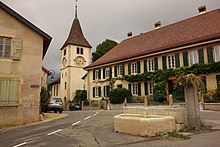
Johann George Adam Forster, also known as Georg Forster, was a German geographer, naturalist, ethnologist, travel writer, journalist and revolutionary. At an early age, he accompanied his father, Johann Reinhold Forster, on several scientific expeditions, including James Cook's second voyage to the Pacific. His report of that journey, A Voyage Round the World, contributed significantly to the ethnology of the people of Polynesia and remains a respected work. As a result of the report, Forster, who was admitted to the Royal Society at the early age of twenty-two, came to be considered one of the founders of modern scientific travel literature.

Caroline Schelling, née Michaelis, widowed Böhmer, divorced Schlegel, was a noted German intellectual. She was one of the so-called Universitätsmamsellen, a group of five academically active women during the 18th and 19th centuries, daughters of academics at Göttingen University, alongside Meta Forkel-Liebeskind, Therese Huber, Philippine Engelhard, and Dorothea Schlözer.

Georg Gottfried Gervinus was a German literary and political historian.

Isabelle de Charrière, known as Belle van Zuylen in the Netherlands, née Isabella Agneta Elisabeth van Tuyll van Serooskerken, and [Madame] Isabelle de Charrière elsewhere, was a Dutch and Swiss writer of the Enlightenment who lived the latter half of her life in Colombier, Neuchâtel. She is now best known for her letters and novels, although she also wrote pamphlets, music and plays. She took a keen interest in the society and politics of her age, and her work around the time of the French Revolution is regarded as being of particular interest.
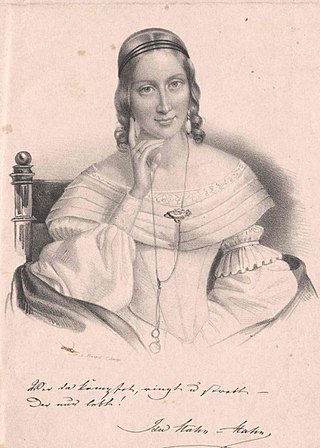
Countess Ida von Hahn-Hahn was a German author from a wealthy family who lost their fortune because of her father's eccentric spending. She defied convention by living with Adolf von Bystram unmarried for 21 years. Her writings about the German aristocracy were greatly favored by the general public of her time. Ida von Hahn-Hahn often wrote about the tragedies of the soul and was influenced by the French novelist George Sand. She "was an indefatigable campaigner for the emancipation of women" and her writings include many strong female characters.

Ludwig Ferdinand Huber or Louis Ferdinand Huber was a German translator, diplomat, playwright, literary critic, and journalist. Born in Paris, Huber was the son of the Bavarian-born writer and translator Michael Huber and his French wife Anna Louise, née l'Epine. He grew up bilingual in French and German after his parents moved to Leipzig when he was two years old. He lacked a classical education but read voraciously and was well versed in modern languages, and started publishing translations from French and English at an early age. He also translated plays that were performed in theatres all over Germany. In the early 1780s, Huber became friends with the jurist Christian Gottfried Körner, his fiancée Minna Stock, and her older sister Dora Stock, whom he later promised to marry. Together, the friends wrote in admiration to the poet Friedrich Schiller and successfully invited him to come to Leipzig. Körner and Minna were married in 1785 and lived in Dresden, where they were joined by Dora, Schiller, and finally Huber, who shared a house with Schiller.

Therese Huber was a German author. She was one of the so-called Universitätsmamsellen, a group of five academically active women during the mid-18th and early 19th centuries. The group consisted of daughters of academics at Göttingen University; Huber was noteworthy among them, alongside Meta Forkel-Liebeskind, Caroline Schelling, Philippine Engelhard, and Dorothea Schlözer.
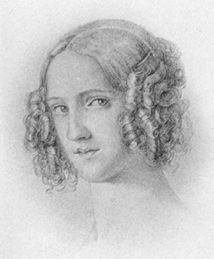
Josephine Caroline Lang was a German composer. Josephine Lang was the daughter of Theobald Lang, a violinist, and Regina Hitzelberger, opera singer. Her mother taught young Josephine how to play piano, and from age five it became apparent that Josephine was possessed with great potential as a composer. As early as age eleven Josephine started giving piano lessons herself. Through her godfather, Joseph Stieler, Josephine was exposed to some of the greatest artists of her time. Both Felix Mendelssohn and Ferdinand Hiller went to great lengths to ensure that Lang learned the proper theory for song-writing, and used their connections to publish Lang's music. Even Robert Schumann published a song of Josephine's in Neue Zeitschrift für Musik in 1838.

Princess Agnes of Anhalt-Dessau was the eldest daughter of Leopold IV, Duke of Anhalt by his wife Princess Frederica of Prussia. She was a member of the House of Ascania, and by her marriage to Ernst I, Duke of Saxe-Altenburg, Duchess consort of Saxe-Altenburg.

Catharina Elisabeth Goethe, born Catharina Elisabeth Textor, was the mother of German playwright and poet Johann Wolfgang von Goethe and his sister Cornelia Schlosser. She was also known by the nickname Frau Aja and the title Frau Rat.

Adolf Schrödter or Adolph Schroedter was a German painter and graphic artist; associated with the Düsseldorf school of painting. He is considered to be one of the pioneers of German comics.
Henriette Marie Françoise L'Hardy was the lady's companion from the Principality of Neuchâtel of the countess Sophie von Dönhoff, the Prussian lady-in-waiting and a morganatic spouse by bigamy to King Frederick William II of Prussia. She made a self-portrait.
Karoline von Woltmann, née Stosch was a German author who also wrote under the pseudonym Luise Berg. She was regarded by her contemporaries as "the German Genlis".
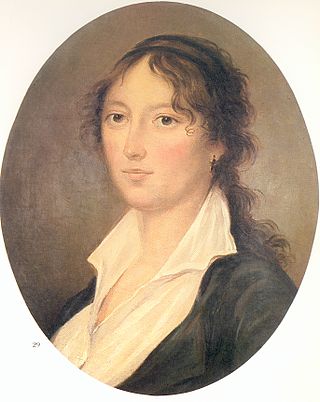
Isabelle Morel was a French-speaking Swiss writer, translator and woman of letters who was most notable for her novel Louise et Albert.

The Morgenblatt für gebildete Stände was a German cultural and literary journal that existed from 1807 to 1865. It appeared daily until 1851, when it was changed to a weekly journal. The Morgenblatt was published by Cotta in Tübingen and later in Stuttgart, and was the most important German literary and cultural journal of its time.

Resolution is a 2016 historical novel by English writer A. N. Wilson. It is a fictionalised account of the life of the 18th century German naturalist, writer and revolutionary George Forster. Main aspects of Forster's life covered by the novel include his participation in the second voyage of James Cook, his marriage to Therese Heyne and his experiences in the French Revolution as a protagonist of the Republic of Mainz. The book is based on historical sources including the journals of Cook and of Forster's father Reinhold as well as Forster's works, but includes also some invented figures and deliberately deviates from some historical facts.
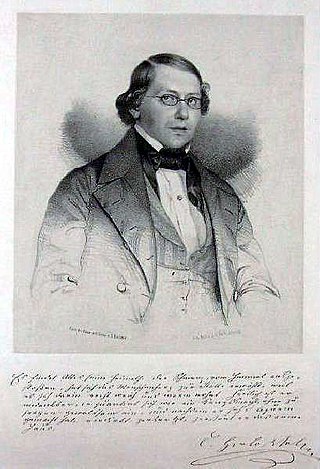
Carl Herloßsohn or Karl Herloßsohn was a German author, journalist and encyclopaedist.

Clara von Greyerz was a German papercutting artist. She was born in Mainz, the daughter of world traveller Georg Forster and his wife Therese. Her father became a revolutionary in the Republic of Mainz from 1792 until his death in 1794, while her mother lived in the Neuchâtel area with her lover and eventual husband Ludwig Ferdinand Huber. The family moved to Tübingen, Stuttgart and Ulm, where her stepfather died in December 1804, when she was already engaged to the forester Gottlieb von Greyerz. They married in 1805, living in Stoffenried, Günzburg, Augsburg and Bayreuth, and had ten children between 1806 and 1832. In Augsburg, von Greyerz became acquainted with Hortense de Beauharnais, and her children played with Hortense's son, the future Napoleon III of France. Von Greyerz was known for her papercuts, some of which she swapped with fellow artist Luise Duttenhofer. In 1836, she visited Hortense at Arenenberg and published a report of her experiences there.

Baron Ernest Albert von Hügel, was a Royal Württemberg Chamberlain and Royal Cavalry Captain who was Lord of Eschenau.

Michael Huber was a German writer, translator and art expert. Born in Bavaria, he moved to Paris as a young man, where he probably worked as a language teacher. In the 1750s, he became a contributor to a French literary journal presenting foreign literature and started translating; his successful translations of the works of the Swiss poet Salomon Gessner into French were instrumental in popularising Gessner's works outside German-speaking areas. Huber also published an anthology of German poetry in French, with an introduction that separated German literary history into four distinct eras and was also translated into German.

